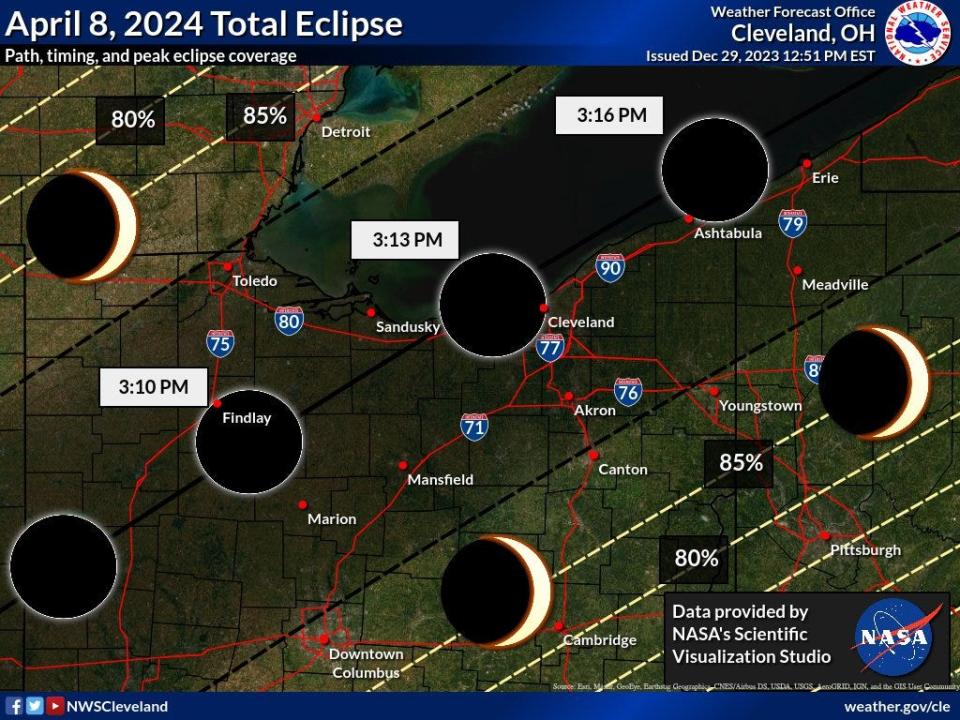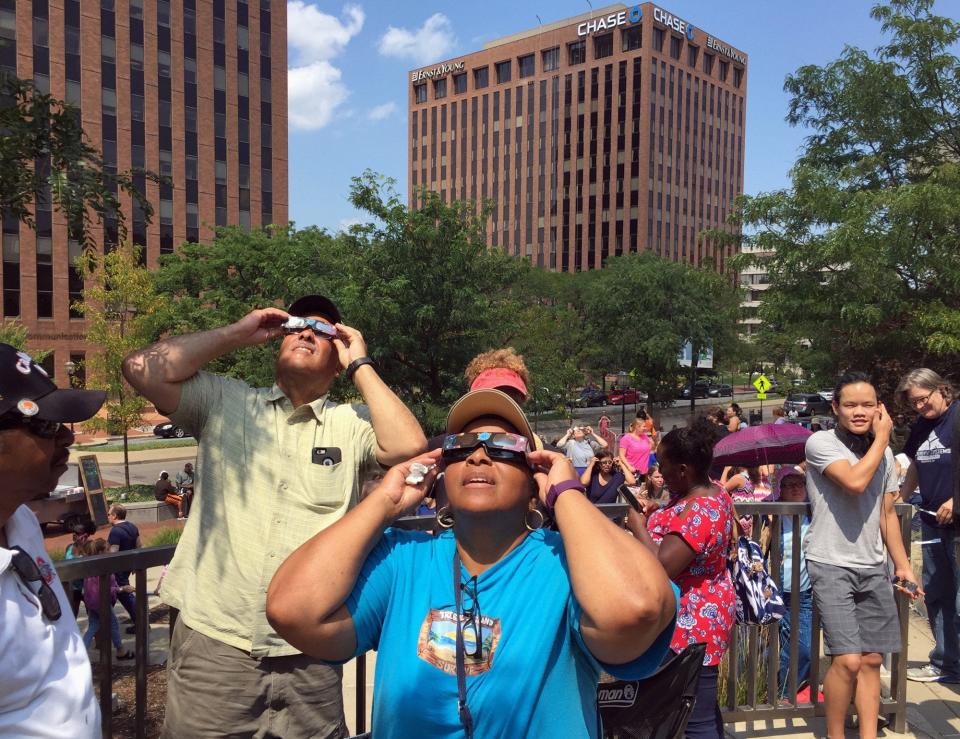Eclipse warning: Summit County is urging residents to stay home on the day of the eclipse
Summit County is urging residents to stay home on April 8.
And don't look directly at the sun as the moon obscures its view in northern Ohio.
County leaders, along with emergency planners and experts from the NASA and the National Weather Service, held an online Town Hall gathering on County Executive Ilene Shapiro's Facebook page this week to discuss the potential impacts the total eclipse will have on Summit County.
Eclipse countdown: Don't be in the dark about the total eclipse. Here's what you need to know
The general consensus is this will be a once-in-a-lifetime event that should not be missed.
And county officials say the best view will be in your own backyard or a park within walking or biking distance of your home.
The biggest concern is the crush of out-of-town visitors who are expected to descend on northern Ohio.

Potential eclipse tourists could create gridlock in northern Ohio
A total eclipse in Ohio hasn't happened since 1806 and it won't happen again until 2099.
This is a once-in-a-lifetime event for northern Ohio and Summit County officials say it is such a momentous event they expect tens of thousands from nearby and far away to come here to be a part of history.
They can't put a number to their prediction − other than it could be a lot of visitors.
More: 100K eclipse glasses ordered for Ohio state parks
The concern is not so much the hours leading up to the big event, said Emergency Management Director Thomas Smoot, but the minutes and hours after the totality that will be at at 3:15 p.m. and last two minutes and 49 seconds in Greater Akron.
The fear is a "let's beat the traffic mentality" will set in, Smoot said, with everyone rushing to get home and visitors anxious to get out of northern Ohio all at the same time.
There are horror stories of gridlock traffic on interstates and thoroughfares − lasting hours on end − from previous total eclipses in other parts of the country.
Smoot said this is why the county is urging residents to enjoy the eclipse close to home and for visitors to arrive early and stay late.
A fair number of northern Ohio school districts have already cancelled classes for the day and others are having early dismissal, Smoot said, so buses are not on the roadways during the peak of the eclipse and the anticipated crush of traffic right after.
"We want to make sure everyone has a safe experience," he said.
The concern is the anticipated traffic jams with more vehicles than the roads can handle and the ability for police and fire departments to be able to respond to any emergency calls that might arise.
In a strange way, Summit County Public Health Commissioner Donna Skoda said, residents should prepare for the eclipse like they would for a major storm or a calamity.
The county is suggesting that residents take care of any errands ahead of time and avoid unnecessary travel.
Skoda said those who have to travel in the region should be prepared that even a simple trip might not be so simple on April 8.
Motorists should make sure they have a full tank of gas and food and water in the vehicle before venturing out should they get stuck in stalled traffic.
"We are telling everyone to stay home and watch the eclipse there," she said.
Just where the troublesome traffic spots will be is hard to predict − a lot like what the weather might be like on April 8.
Freddie Zeigler, of the National Weather Service, said they can look at historical trends for the weather in northern Ohio for some insight. And that is not too promising.
Looking back at the weather records for the date show there's under a 10% chance of totally clear skies.
The weather in April can have extreme swings with bone-chilling cold to warm spells.
It could rain and it might even snow.
Zeigler said the weather service will have a full contingent of meteorologists on hand to assist county emergency planners should severe weather from thunderstorms or even snow squalls develop during the eclipse.
Any severe weather, he said, could further complicate folks trying to get back home after the event.
The weather service says it should have a better handle on the potential weather conditions for the eclipse around April 1.
Another worry for planners, Zeigler said, is the potential for the varying conditions in northern Ohio.
It is quite possible there could be lake effect clouds in Cleveland and, at the same time, sunny skies in Akron.
Zeigler said the worry is residents and visitors will attempt to follow the sun to find clear skies creating unexpected traffic headaches and a surge in crowds in unprepared areas.
"There are going to be some issues (that day) we don't normally think about," he said.

Public health concerns in Summit County the day of the eclipse
The biggest concern the day of the eclipse is the most obvious one.
Skoda said the county is working to hammer home to everyone that it is never safe to look directly at the sun.
And the day of the eclipse is no different.
The best protection for your eyes, she said, is to purchase special eclipse viewing glasses well ahead of time.
There are other public health concerns too.
Skoda said residents should be mindful when hosting large gatherings on their properties.
Like any party, she said, ensure guests don't drink too much.
And those who have septic systems or wells should be mindful of potential damage to underground equipment by parking vehicles on the lawn.
Anyone planning to host overnight guests, she said, should also remember that more than five tents on a property is considered operating a campground and subject to a whole laundry list of rules and regulations.
Another concern is the anticipated large number of vehicles on the roadways combined with an anticipated large number of spectators and visitors walking along the sides of roads, particularly in and around parks and large gatherings.
This is a momentous event for the region, Skoda said, and folks should have fun but be mindful this will be far from a typical day.
"We want people to take this seriously," she said.
What's the eclipse timeline in Greater Akron?
The National Weather Service says the eclipse will start in Texas and then make its way across the country, passing over states including Oklahoma, Arkansas, Missouri, Illinois, Kentucky and Indiana before arriving in Ohio.
For Greater Akron, the eclipse will begin at 1:59 p.m. as the moon slowly casts its shadow across the sun.
Totality or complete darkness in Akron will be at 3:15 p.m. and last two minutes and 49 seconds.
It will slowly get brighter outside, and the eclipse will end at 4:29 p.m.
Findlay will experience totality between 3:10 p.m. and 3:15 p.m.
For Cleveland, it will be totally dark between 3:13 p.m. 3:17 p.m.
And in Erie, Pennsylvania, the totality will be between 3:16 p.m. and 3:20 p.m.
What to expect when the eclipse happens?
Things will progress slowly during the eclipse.
It will seem like nightfall as things slowly get darker.
But it will get darker from above instead of from the west.
At the peak of totality, it will be as dark as night in northern Ohio and street lights will come and birds will likely retreat to their nests.
The temperature will also go down by as much as 15 degrees.
And then, the reverse will happen.
It will get progressively brighter as more and more of the sun becomes exposed.
This article originally appeared on Akron Beacon Journal: Summit County urges residents to stay home on the day of the eclipse

